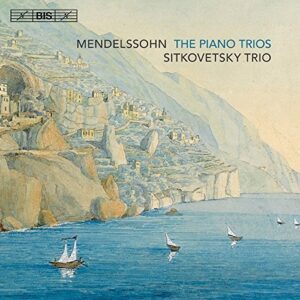The Mendelssohn Piano Trios live an existence in fame-limbo: not neglected but not quite part of the hard core of piano trios that the works of Mozart, Beethoven, Brahms, Schubert, Dvořák, and Schumann occupy. Within Mendelssohn’s œvre they don’t have the beaming geniality of the Octet nor the fierce depth of the string quartets. But they are splendid pieces in their own right and the recording catalog offers a decent—if not overwhelming—number of options, many of them very good. This release with the Sitkovetsky Trio joins them—just.
It’s not for lack of skill: Alexander Sitkovetsky is above reproach on any technical account and cellist Leonard Elschenbroich (by now no longer a member of this group) is a standout cellist. And when pianist Wu Qian doesn’t hold back too much (which, alas, she does for too much of these two trios), she delights with individual phrases, and never engages in any pedal-smudging. (Although, to mention only one pianist, I still prefer Susan Tomes of the Florestan Trio.) For all the qualities, some of them very much in-your-face, it doesn’t amount to much, somehow, because theirs is at times a hollow excellence: “Molto allegro agitato” their first movement of the Op. 49 Trio certainly is, but the smoothly forward-pushing approach, cruising through the notes with nominal reverence shown to the dynamic markings, leaves a dint of an unvaried, unforgiving, charmless, and hard rendition. A Soviet speed skater on route to the world record, perhaps, but not a method actor telling a captivating story.
The Andante con moto tranquillo, now surprisingly slow, is clear as a mountain brook; no excess of sentimentality but not lacking in lyricism, either, with dry, pointed, perhaps slightly sober violin playing in which each note is detailed and perfectly accurate. The musicians hurl themselves into the Scherzo—a good deal faster than the 120 per dotted quarter note—before settling on a pliable tempo just a shade above the already rather speedy indication in the score. Neither Trio is an entirely sunny piece—a mistake the Sitkovetsky Trio astutely avoids making: they are intense works. But something about the Sitkovetsky’s intensity goes overboard as they chase expressive extremes, at least in the First Trio.
The Second Trio fares quite a bit better. While similar problems subtly haunt the opening Allegro energico con fuoco (almost too “energico”, too “Allegro”, and with a rather cold flame: the amassed energy of the movement’s finale disperses immediately), the Andante espressivo (faintly reminiscent of the Londonderry Air a.k.a. “Danny Boy”) is very fine in its detached tenderness and again as slow as the fast movements are brisk. The spidery fast Scherzo features the Sitkovetsky’s musical high-altitude approach at its most successful: a graceful and impressive feat. What’s lacking in the overall impression is an element of emotional satisfaction that’s hard to put one’s finger on, but that ensembles such as the Abegg Trio, Trio Wanderer, Trio Fontenay, and Florestan Piano Trio offer more readily, even if not all of them are as accurate or energetic in their playing.
































